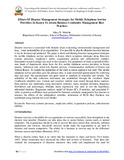Effects Of Disaster Management Strategies for Mobile Telephone Service Providers In Kenya To Attain Business Continuity Management Best Practices
Abstract
Disaster recovery is associated with broader issues concerning environmental management and
long – term sustainability of an organization. It is possible to plan for disaster recovery because
it can be foreseen and predicted. The paper is about establishing disasters management strategies
for mobile telephone service providers in Kenya which comprises strategies along Recovery
systems processes, employee’s safety, organization policies and infrastructure stability.
Descriptive research design was used in this research. The population of study consisted of fiftynine
heads of departments taken from the five mobile telephone service providers in Kenya
namely; Safaricom Ltd, Airtel Ltd, Equitel services, Communication Authority of Kenya and
Telkom Kenya. To sample the population of the study a census approach was used. The mobile
telephone service providers gave the primary data. A semi-structured questionnaire for collecting
data was used. The questionnaire was pilot tested to establish its reliability and validity. The
reliability of the data collection instrument was established through the Cronbach Alpha
Coefficient reliability test. Content and construct validity were tested through factor analysis.
Data analysis was undertaken using descriptive statistics; mean, standard deviation, frequency
distribution and percentages, Multiple linear regressions was used to test the hypothesis,
inferential statistics; Regression analysis model of fitness (R2), F-statistics, and associated Pvalue,
regression coefficient were generated for business continuity management best practice to
measure the effects of the independent variables. Attainment of BCM Best Practices was
established using Gartner Six Level Model.

